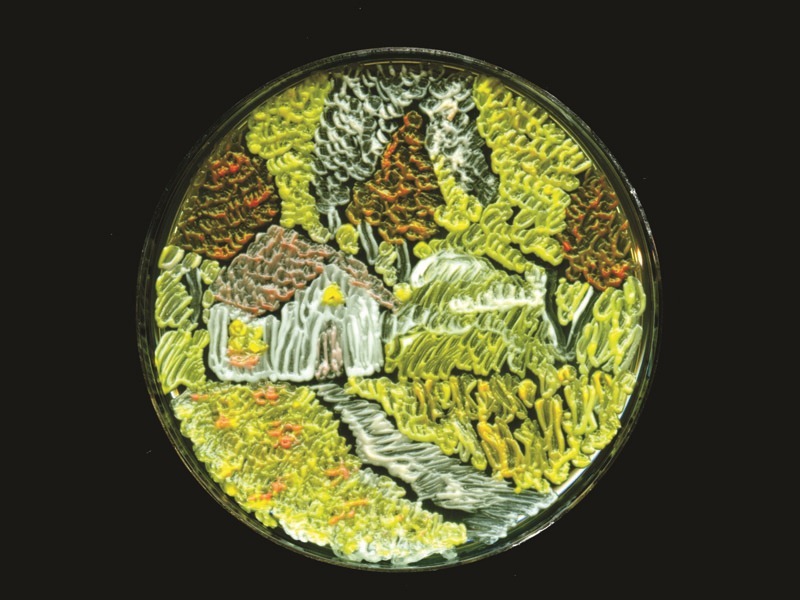The American Society for Microbiology launched its first ever Agar Art contest, inviting microbiologists to unleash their hidden creative genius and produce a piece of art using microbes and petri dishes as tools. Looking through the galleries of the winning entries, as well as many of the submissions, we can see that many participants got really carried away.
The first place was taken by molecular biologist Mehmet Berkmen of New England Biolabs, and mixed media artist Maria Penil for their creation “Neurons”.
“Neurons and biological shapes is a common theme in the works of the artist Maria Penil,” the entry explains. “Here she painted with yellow Nesterenkonia, orange Deinococcus and Sphingomonas isolated for their attractive colors as contaminants in the Berkmen lab. After growing the plates for 2 days at 30C, the artist usually lets the plate sit for few more days before permanently sealing the work in epoxy.”
The winner of the “People’s choice” award for “Cell to Cell” — a painting made using bacteria on agar and sealed in epoxy, by Maria Penil.
The entry “Neurons” that won the first place.
Coming runner-up was “NYC Biome MAP” — an entire map of Manhattan created using microbes and agar created as a collaboration between citizen scientists and artists at Genspace: New York City's Community Biolab. Christine Marizzi, an educator at a community lab, explains how it was created:
We invited the public to learn about microbes by creating a city map using harmless Escherichia coli K12 bacteria engineered with colorful fluorescent proteins like GFP, RFP or YFP as paint. More than fifty participants applied bacterial suspension cultures onto square petri plates containing standard LB selection media. The plates were prepared with stencils of NYC’s street grid, allowing participants to paint the bacteria into the patterns. After a short incubation time, participants returned to print the grown colonies on paper. The bacterial prints were reassembled into the map of NYC, blending the individual prints into a collective artwork and creating an everlasting microbial map of NYC.
“NYC Biome MAP”
The third place went to Maria Eugenia Inda, a postdoctoral researcher from Argentina working at Cold Spring Harbor Labs, for her work “Harvest Season”. This piece was created using a species of yeast named saccharomyces cerevisiae which is one of active agent responsible for our most basic foods - bread, wine, and beer. Maria Eugenia Inda explains her work:
The organism used for this piece of art were metabolically engineered on the b-carotene pathway, resulting in a color palette of colonies of our choice, from yellow to red. The painting depicts a humble farmhouse with the wheat production laced in the countryyard. Amazed by the plasticity of this organism for engineering during the Yeast Genetics & Genomics Summer Course at CSHL I got inspired to paint this agar with the message: “Look at the Yeast field, for they are already white for harvest!”

“Harvest Season”
Other standouts include a recreation of Van Gogh’s “Starry Night”, a picture resembling a night sky and a portrait of Louis Pasteur.
Source: Microbe World via Junk Culture



















I hardly understand a word of this article. 'LB selection media' 'b-carotene pathway' ???
ReplyDeleteWill someone please explain exactly HOW these artworks were made?